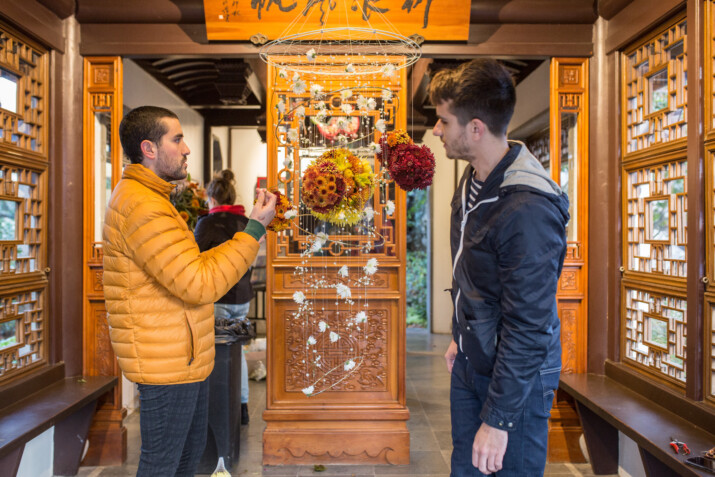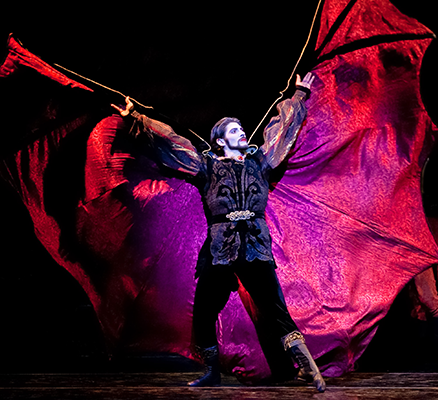
Samudra (in water), a 4-year-old Asian elephant calf, plays with his mother, Rose-Tu, at the Oregon Zoo. Rose-Tu is expected to give birth to her second baby this fall. Photo by Michael Durham, courtesy of the Oregon Zoo.
Although the Asian elephant’s looming late-autumn due date has spurred the Oregon Zoo into birth planning mode, curator Bob Lee said Rose-Tu’s exercise routine is the norm for the entire herd.
“We’re dedicated to their health and welfare year-round,” Lee said. “Being fit for pregnancy is just one aspect of that.”
Rose-Tu will keep an active schedule right to the very end of her 22-month gestation. Until then, zoo staff will work to create the most peaceful environment possible for her during the two-month window in which she might give birth.
Last spring, the Oregon Department of Transportation agreed to halt a repaving project on Highway 26 from November to February. Zoo staff worried that the low-frequency rumble of grinders and pavers might distress Rose-Tu during the critical final stage of her pregnancy.
“Elephants can be difficult obstetrical patients due to their extreme size,” said Mitch Finnegan, the zoo’s senior veterinarian. “They’re also sensitive to distractions, which can complicate the delivery process.”
According to Dr. Finnegan, the key to a successful elephant calf delivery is a physically fit mother giving birth under familiar, stress-free conditions.
“Daily exercise will help her develop the muscle tone required to deliver a 250-pound baby,” Finnegan said.
Curator Bob Lee and staff will carefully monitor Rose-Tu’s diet to keep her weight — and the baby’s weight — in check. Unlike humans, fetal elephants can’t be regularly monitored through ultrasound.
“We can see the baby toward the beginning of the pregnancy with specialized ultrasound equipment,” Finnegan said. “But later it becomes so large that it looks kind of like a fog bank rolling in and out of view — very big and nondescript.”
By the last third of pregnancy, the calf’s movements can be seen and sometimes felt through Rose-Tu’s belly.
In early September, keepers drew blood from the calf’s father, Tusko. Plasma will be extracted from that blood and banked as an insurance policy — one that proved critical following the birth of Rose-Tu’s first calf, Samudra, in 2008.
“When a calf is born, it gets a lot of antibodies from nursing on colostrum, the earliest milk produced by the mother,” Finnegan said. “If the calf is too weak for that initial nursing, we can administer plasma to provide those antibodies.”
Staff members monitor Rose-Tu’s progesterone levels once a week. Toward the end of the pregnancy, they’ll monitor daily. Once a precipitous drop is detected, the calf is likely due in one to three days.
“Rose-Tu will release another hormone called relaxin, which humans also produce,” Finnegan said. “The elephant’s joints get sloppy, everything loosens up and the top of the tail gets swollen.”
Despite the various clues, predicting an elephant’s due date is something of a mysterious art. With a 22-month gestation period — the longest of any animal — arriving “a little early” can mean several weeks.
The Oregon Zoo’s elephant births — starting with the birth of Packy in 1962 — have played a key role in establishing what is known about elephant gestation. Finnegan said Dr. Matthew Maberry, the Oregon Zoo veterinarian who attended Packy’s birth, had an excellent eye for predicting elephants’ birthing dates. “He predicted Samudra’s birthday in 2008 very accurately, simply by the appearance of his mother, Rose-Tu, late in her pregnancy.”
Well before Rose-Tu delivers, several rooms in the elephant barn will be filled with emergency medical equipment. Stimulants will be on hand in case Rose-Tu needs to be induced. Oxygen (which is administered through a tube in the calf’s trunk) will also be available if her newborn calf shows any signs of difficulty breathing.
“We’ll have several carts of equipment and hopefully we’ll use none of it,” Finnegan said. “We’re expecting the best and preparing for the worst.”
As Rose-Tu approaches labor, windows will be blacked out and lights will be dimmed nightly to maintain her circadian rhythm. Staff will be minimized in the area and closed-circuit cameras will be fed to a room nearby. Adult male elephants will continue to be rotated throughout the facilities.
“We want the rest of the herd to experience the birth,” Lee said. “They’ll all bear witness to it.”
The new arrival will have a profound effect on Samudra, the current baby of the herd. His role will change as his mother’s attention shifts to the newborn.
When Samudra was born, Rose-Tu’s labor lasted 33 hours and had to be induced. The key to a shorter delivery, according to Dr. Finnegan, is a consistent routine and a healthy dose of privacy.
“There’s a classic story about a thoroughbred horse about to foal,” Finnegan said. “The owner stays in the stable fretting for hours on end over the nervous mare, who has her knees pressed firmly together. The exhausted owner eventually steps out for some coffee, and when she comes back there’s a foal on the ground.”
If the birth is successful, the vets will perform a neonatal exam to count toes, determine sex and check blood. After that, they’ll stay out of the way as much as possible to let the baby and mother bond.
Story submitted by Hova Najarian at Oregon Zoo.
















